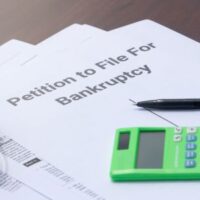Rising Bankruptcy Filings Reflect Growing Economic Pressures: A Closer Look at California and Beyond

The economic landscape following the global pandemic has presented significant financial challenges for individuals and businesses alike. Despite a brief decline during the pandemic era, largely attributed to federal aid and temporary relief measures, the number of bankruptcy filings has been steadily increasing, signaling deeper economic distress for many Americans.
According to recent statistics from U.S. Bankruptcy Courts, 517,308 bankruptcy cases were filed in 2024, marking a notable 14.2% increase from the 452,990 cases filed the previous year. Though these numbers are still below pre-pandemic figures, the upward trend is unmistakably reflective of broader economic challenges faced by both households and businesses.
We can attribute this rise primarily to mounting financial strains caused by persistent inflation, higher borrowing costs, and the expiration of pandemic relief efforts. With more Americans now burdened by expanding debts and escalating costs of living, bankruptcy remains an essential tool for providing relief and a fresh financial start.
Personal vs. Business Bankruptcies
Bankruptcies are primarily categorized into personal and business filings. Personal bankruptcies dominate the statistics, accounting for the vast majority of all filings. In 1980, business bankruptcies represented about 13% of total filings; however, by 2024, this number significantly dropped to approximately 4.4%. This shift underscores the evolving nature of economic distress, increasingly concentrated among individual consumers rather than corporate entities.
Personal bankruptcies commonly involve Chapter 7 or Chapter 13 filings. Chapter 7 bankruptcy liquidates nonessential assets to repay debts and offers debt discharge relatively quickly. Chapter 13, conversely, allows individuals to set up manageable repayment plans over three to five years, ultimately discharging any remaining unsecured debts at the conclusion of the plan.
Businesses typically turn to Chapter 7 for complete liquidation or Chapter 11 for restructuring and reorganization while continuing operations. Chapter 11 is particularly suitable for larger corporations and occasionally high-earning individuals whose debt levels exceed Chapter 13 thresholds.
California Leads in Bankruptcy Filings
California consistently ranks among the states with the highest number of bankruptcy filings. In 2024 alone, California reported 47,621 filings, the most in the nation. However, when considered per capita, California has approximately 119 bankruptcy filings per 100,000 residents—a significantly lower rate compared to other states like Georgia, where more lenient bankruptcy laws and weaker consumer protections result in a dramatically higher rate of 763 bankruptcies per 100,000 residents.
Despite California’s relatively moderate rate when adjusted for population, the absolute number of bankruptcies highlights the substantial financial struggles many Californians face. This situation underscores the critical role of experienced Los Angeles bankruptcy lawyers who can guide individuals and businesses through the complex legal landscape, maximizing the financial relief bankruptcy laws offer.
Understanding the Causes of Bankruptcy
Bankruptcy rarely results from a single financial setback; rather, it typically arises from a combination of factors. The most frequently cited causes include unexpected medical expenses and job loss or income reduction. A report by the Consumer Bankruptcy Project revealed that 78% of bankruptcy filers experienced a significant decline in income, while 65% cited medical expenses and related disruptions as major contributing factors. The Kaiser Family Foundation further highlights the pervasive issue of medical debt, reporting that 41% of Americans hold some form of medical-related debt.
Unsecured debts, such as credit card balances and student loans, further compound these financial pressures. Changes in personal circumstances—like divorce or caring for a family member—can also exacerbate existing financial vulnerabilities, tipping many individuals over the financial edge into bankruptcy.
Changing Demographics and Repeat Filers
Bankruptcy filers tend to fit certain demographic profiles consistently. Individuals without college degrees, middle-aged or older adults, and single women frequently represent the largest groups filing for personal bankruptcy. Remarkably, seniors aged 65 and older have become the fastest-growing demographic in bankruptcy filings, reflecting both an aging population and increasing financial vulnerability among older Americans.
Repeat bankruptcy filings also highlight persistent financial challenges. In 2023, 35% of Chapter 13 filers reported having previously filed within the last eight years. While there are no restrictions on the number of bankruptcy filings allowed, mandatory waiting periods between filings can limit the immediate relief available to repeat filers, emphasizing the importance of careful financial planning and sound legal advice.
Navigating Bankruptcy with Expert Assistance
The complexities of bankruptcy law, combined with the emotional strain of financial difficulties, can make navigating bankruptcy particularly challenging. Given California’s unique laws and its high absolute number of bankruptcy filings, residents facing financial distress should seek guidance from knowledgeable professionals. Experienced Los Angeles bankruptcy lawyers can help clients understand their options, choose the most suitable type of bankruptcy, and manage the entire process efficiently.
Contact Wadhwani & Shanfeld
If you or your business are grappling with financial pressures and considering bankruptcy, you don’t have to face it alone. The compassionate and skilled attorneys at Wadhwani & Shanfeld are committed to providing personalized legal counsel tailored to your specific circumstances.
Take the first step toward regaining financial control and peace of mind by contacting our office today.
Source:
debt.org/bankruptcy/statistics/
